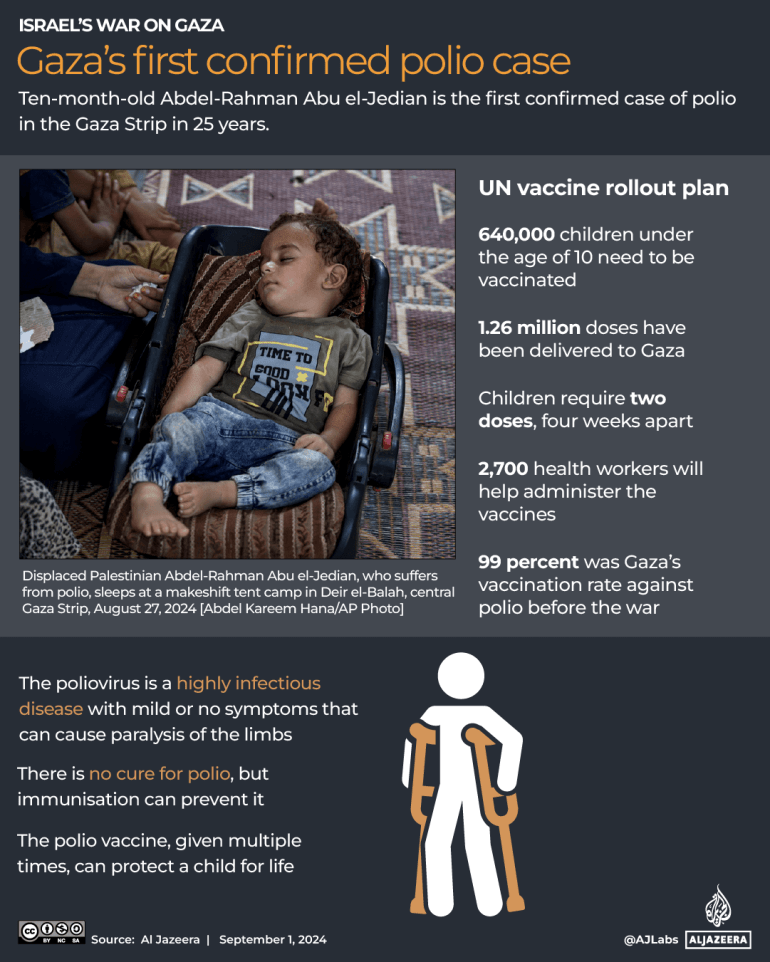The United Nations, in collaboration with Palestinian health authorities, has officially begun a campaign to vaccinate children in the Gaza Strip against the poliovirus, which can cause paralysis of the limbs or even death in children.
This comes after the virus, previously defeated in the enclave following a mass vaccination drive, was discovered last month after 25 years. The detection of the polio case highlights the collapse of Gaza’s health infrastructure due to almost 11 months of nonstop Israeli bombardment.
Here’s what we know about the state of the rollout amid the devastating war on Gaza that has killed more than 40,700 Palestinians, including close to 17,500 children.
What is polio and how is it back in Gaza?
Polio is a serious infection that can spread quickly, especially in unhygienic conditions, as it can be transmitted through contact with excrement. It can also spread through coughs and sneezes, though it is less common.
Most people do not exhibit symptoms after contracting the virus, with some showing mild, flu-like symptoms like high temperature, fatigue and headaches that usually last up to 10 days. But the virus can also affect the brain and nerves, leading to paralysis and in some cases even death.

The Israeli military has destroyed water supply and wastewater disposal networks across the Palestinian territory, with waste accumulating near tiny areas where hundreds of thousands of civilians are forcibly displaced.
According to the Government Media Office in Gaza, the Israeli army has also stopped transferring the waste away from civilian areas by imposing control over waste dumps and targeting municipality workers, machinery and mechanisms in place to manage waste.
Abdel-Rahman Abu el-Jedian, a 10-month-old Palestinian, became partially paralysed last month after contracting polio, which he had been unable to receive because his family was repeatedly displaced as a result of Israeli military operations.
According to the World Health Organization (WHO), an interruption in routine immunisation campaigns in the occupied Palestinian territory, including Gaza, has contributed to its re-emergence.
How will the vaccination campaign work?
About 2,700 health workers are involved in the campaign, backed by the WHO, UNICEF and the UN’s agency for Palestinian refugees or UNRWA in collaboration with the Ministry of Health in Gaza.
It formally started in the central part of the enclave on Sunday, where it would last through September 4, before moving to Khan Younis and Rafah in the south (September 5-8) and northern Gaza governorates (September 9-12).
Children in #Gaza have started receiving polio vaccines this morning. This is today in Nuseirat.
The vaccination campaign has begun in the Gaza middle area, where over 200 of our teams are administrating vaccines in 28 @UNRWA health facilities and going tent to tent#UNRWAworks pic.twitter.com/xkZtVxDOCJ
— UNRWA (@UNRWA) September 1, 2024
A handful of children were given the first few doses at Nasser Hospital in Khan Younis on Saturday before the large-scale rollout started.
Some 640,000 children aged between one day and 10 years will receive the type two poliovirus vaccine, to be administered as two oral drops.

Is there a truce during the vaccination drive?
Fighting has been paused in a few designated areas of the Strip to allow health centres to administer the doses.
But any reports of a general ceasefire in the enclave are false, according to the office of Israeli Prime Minister Benjamin Netanyahu.
“Israel will allow only a humanitarian corridor through which the vaccinators will pass and demarcated areas will be established that will be safe for administering the vaccine for a few hours,” it said in a statement on Sunday.
“Israel sees importance in preventing the outbreak of polio in the Gaza Strip including in order to prevent the spread of epidemics in the region.”
According to the UN, the initial length of the “humanitarian pause” agreed to allow the vaccination is from 6am to 3pm (09:00-18:00 GMT) every day.
Top UN officials have earlier emphasised that the only effective way to vaccinate all children against the virus and a variety of other virulent diseases spreading through Gaza is by achieving an immediate and lasting ceasefire.
Are the vaccines safe?
According to the UN, news stories appeared online in Israel and the United States, quoting Israeli scientists falsely asserting that the polio vaccine slated to be used in Gaza is “experimental” and a danger to citizens in both Palestine and Israel.
“I want to make the following clear: the safest and most effective way to protect children against the poliovirus, regardless of the variant, is to vaccinate them,” UN spokesperson Stephane Dujarric told reporters in New York last week.
“This vaccine is safe. It is effective, and it offers top-quality protection. It is a vaccine globally recommended for variant type two poliovirus outbreaks by the World Health Organization.”
Dujarric said more than 1.2 billion doses of the same vaccine have been used to protect children in some 40 countries after it was rolled out in March 2021.
What are the hurdles? Will the drive help prevent polio breakout?
Chessa Latifi, the deputy director of emergency preparedness and response at Project HOPE, said war, forced displacement and the breakdown of the healthcare system in Gaza could hinder the vaccination drive.
“I believe it’s going to [be] really unlikely for the vaccine campaign to reach the 90 percent of children that need to be vaccinated,” Latifi told Al Jazeera from Los Angeles.
“There’s just no guarantee of safety. These people that need to bring their children to these clinics – first of all, do they have access to the clinics? Do they have fuel or the means to get to the clinics? Is it safe? Is it safe for the staff to get to the clinics? I know that we’ve got these brief humanitarian pauses. But is it sufficient? No,” she said.
Latifi, whose organisation operates in Gaza, also said the vaccination drive alone would not help prevent the spread of the virus.
“The vaccine campaign doesn’t address the core issue, which is the lack of hygiene, sanitation and clean water,” she said. “Because if we had those components – the clean water, the proper facilities for bathing and latrines – we wouldn’t have polio. But this infrastructure has been completely destroyed. You have people living in these ad hoc camps. It’s a really really dangerous situation.”
EMEA Tribune is not involved in this news article, it is taken from our partners and or from the News Agencies. Copyright and Credit go to the News Agencies, email news@emeatribune.com Follow our WhatsApp verified Channel





